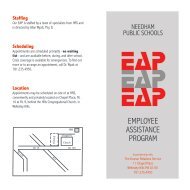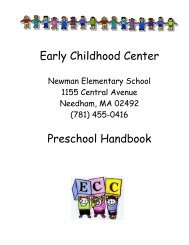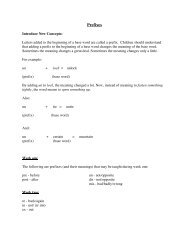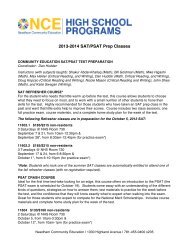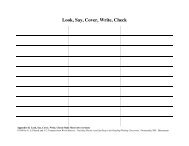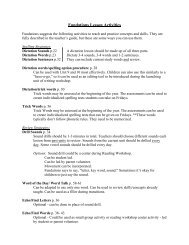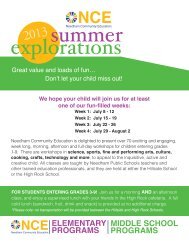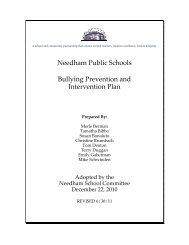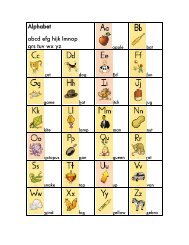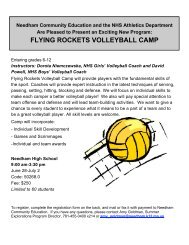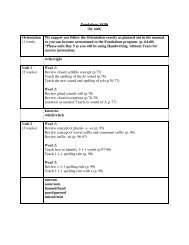POSSIBLE ACTIVITIES FOR INDEPENDENT OR GUIDED PRACTICE
POSSIBLE ACTIVITIES FOR INDEPENDENT OR GUIDED PRACTICE
POSSIBLE ACTIVITIES FOR INDEPENDENT OR GUIDED PRACTICE
Create successful ePaper yourself
Turn your PDF publications into a flip-book with our unique Google optimized e-Paper software.
<strong>POSSIBLE</strong> <strong>ACTIVITIES</strong> <strong>F<strong>OR</strong></strong> <strong>INDEPENDENT</strong> <strong>OR</strong> <strong>GUIDED</strong> <strong>PRACTICE</strong>Activity 1: Choose, Write and Build, and Mix, Fix, Mix K-2(Fountas and Pinnell)This activity helps spellers recognize common patterns.• Teacher provides short, clear, focused spelling lesson on newsound or pattern.• Teacher and students share several known words that usethis principle or pattern. Teacher writes these words onthe board.• Each student chooses 3 or 4 of these words and writes themdown for personal study.• Students spell their words with letter manipulatives and checkstheir spelling against their written model.• Student mixes the letters and respells the words using left toright sequence. Repeat 2 or 3 times.Activity 2: Look, Say, Cover, Write, Check** K-2(adapted from Horn and Fountas and Pinnell) This activityteaches students how to study words using visual memory.• Take a paper with 3-4 columns (attached) and write the list ofwords in the first column.• Begin with one word. Look closely at the letters to notice thevisual details.• Say it, and notice parts to remember.• Cover the word and think about how it looks.• Write it from memory in the next column.• Uncover and check it with the real word.• Repeat until the last column is complete. If it is spelled wrong inthe last column, add the word to the first column againand repeat the process.The first two steps help students make the connection betweenthe visual and sound patterns and also connect meaning tospelling. The third step guides students in seeing a word in theirminds. The fourth step provides practice with retrieving theimage and producing letter strings in correct sequence. Thefinals steps allow students to monitor and, if necessary,immediately self-correct their spelling attempts.Activity 3: Buddy Check** (Fountas and Pinnell) may be used asa pretest and teaches students how to rehearse for spelling test• Students work together dictating their words to each other ontheir Buddy Check sheets.• Partner says word, uses it in sentence, and says word again.• Buddy records word.• When all words are recorded, dictating partner puts an “x”beside misspelled words.• Repeat for buddy.• Words that are misspelled in the last column on the sheet aremade with letter maniplutives.• Misspelled words are then carried over to next weeks list.Activity 4: Make Connections** (Fountas and Pinnell)Making Connections provides for an open-ended task thatengages students in thinking about how words are related.• Students write words at the top of the sheet (attached).• Teacher shows students different ways to make connectionsbetween words.• Students selects a word part connection and records it in box.• Students selects a personal connection and records it in box.This task requires much teaching over a long period oftime and needs to be adjusted to fit the grade andachievement level of particular students.Activity 5: Making Words** (Cunningham)Making words with letter cards is an active way for students tostudy spelling patterns. Students use specific letters and proceedthrough a series of steps to make bigger words until they make thetarget word the teacher has selected. For example, student mightbe given the vowels, a, e, a, and the consonants, b, f, k, r, s, t.The teacher could ask them to use three letters to make the wordbat and then have them add, exchange, and remove letters tocreate a series of one and two syllable words. In the last step,students would use all of the letters to make the large word,breakfast. Students would record all of the words they make andthen do a word sort, grouping the words by sound and/or visualpattern.** See attached worksheet
<strong>POSSIBLE</strong> <strong>ACTIVITIES</strong> <strong>F<strong>OR</strong></strong> <strong>INDEPENDENT</strong> <strong>OR</strong> <strong>GUIDED</strong> <strong>PRACTICE</strong>Activity 6: Word Sorting (Hall, Cunningham, and Cunningham)Sorting words by pattern enables students to see similarities anddifferences among words and to discover important concepts.Word sorting activities are an integral part of spelling instruction. Inword sorting, students look at words and sort them into categoriesbased on sound and spelling patterns. Research had found thatword sorting activities not only increase students’ ability to spellwords, but to read them as wellThere are four basic types of word sorts:• Closed Sort: The teacher asks students to group a set of wordsby a pattern or principle. (e.g. Group all the words by soft andhard g. Group all the words with a changed base word.)• Open Sort: Given a set of words, students discover a commonpattern or principle and group the words accordingly.• Writing Sort: Students are given a sheet with model key wordsat the top. Teacher calls out a word and students write the wordunder the appropriate key word.• Speed Sort: Students try to sort a set of words against theclock.To prepare a word sort:• Select words which represent the spelling pattern or principle thatis being reinforced (e.g. ee words)• Select a contrasting set of words (e.g. short e words)• Mix the groups of words on paper or on individual cards• Ask individuals or partners sort the words• Discuss the groupings at the end of the lesson.Activity 7: Word HuntsIn word hunts, students search environmental print (word walls,class lists, signs, books etc.) and “hunt” through their reading andwriting for words that are examples of patterns they are studying.In this way, they see the connection between spelling and readingand writing. Word hunts also enhance students’ speaking andwriting vocabularies.Activity 8: Word Study Journals (Notebooks)Spelling journals are organized collections of personal wordsstudents use in word sorts and games. Words are selected basedon need or interest, and recorded in the journal.As part of daily practice, students use the notebooks to:• record word sorts• write perceptions and generalizations about sortconcepts• draw and label words that match the key words• drop and add letters to make new words• write sentences, paragraphs, stories using the wordsthey are studying• do word hunts in trade books and content area reading• write tips for remembering hard-to-spell words(e.g. to get her)• play a variety of activities and word games with partnersActivity 9: Cloze (Rebecca Sitton)Make Cloze activities for practice and assessment. These may bestories or expository writing, and are written on black linemasters. Selected “test” words are left blank for students to fill inas they read.A cloze activity may also provide practice for missing letters ofwords e.g. p ple, b tif l.Activity 10: Dictation (C<strong>OR</strong>E Teaching Reading Sourcebook)Dictation activities connect the encoding process (writing) to thedecoding process (reading) by demonstrating that students notonly use sound/spelling knowledge to read, but the sameknowledge allows them to communicate with others throughwriting. Regular dictation of words containing patterns taught inphonics lessons is a useful way to assess student progress. Ifthe length of dictation increases gradually, it also developsstudents’ auditory skills. Dictation progresses from two or threeword sentences to progressively longer sentences. Thesesentences should contain previously taught sound/spellings, aswell as some previously taught priority words.




